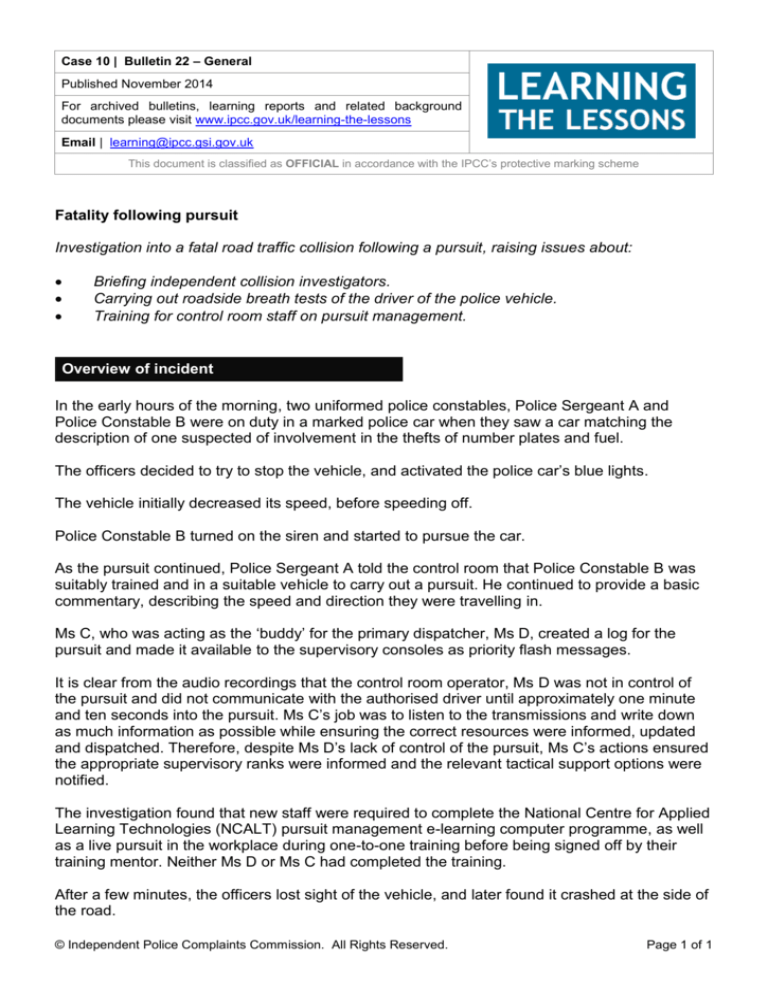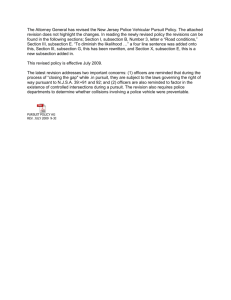
Case 10 | Bulletin 22 – General
Published November 2014
For archived bulletins, learning reports and related background
documents please visit www.ipcc.gov.uk/learning-the-lessons
Email | learning@ipcc.gsi.gov.uk
This document is classified as OFFICIAL in accordance with the IPCC’s protective marking scheme
Fatality following pursuit
Investigation into a fatal road traffic collision following a pursuit, raising issues about:
Briefing independent collision investigators.
Carrying out roadside breath tests of the driver of the police vehicle.
Training for control room staff on pursuit management.
Overview of incident
In the early hours of the morning, two uniformed police constables, Police Sergeant A and
Police Constable B were on duty in a marked police car when they saw a car matching the
description of one suspected of involvement in the thefts of number plates and fuel.
The officers decided to try to stop the vehicle, and activated the police car’s blue lights.
The vehicle initially decreased its speed, before speeding off.
Police Constable B turned on the siren and started to pursue the car.
As the pursuit continued, Police Sergeant A told the control room that Police Constable B was
suitably trained and in a suitable vehicle to carry out a pursuit. He continued to provide a basic
commentary, describing the speed and direction they were travelling in.
Ms C, who was acting as the ‘buddy’ for the primary dispatcher, Ms D, created a log for the
pursuit and made it available to the supervisory consoles as priority flash messages.
It is clear from the audio recordings that the control room operator, Ms D was not in control of
the pursuit and did not communicate with the authorised driver until approximately one minute
and ten seconds into the pursuit. Ms C’s job was to listen to the transmissions and write down
as much information as possible while ensuring the correct resources were informed, updated
and dispatched. Therefore, despite Ms D’s lack of control of the pursuit, Ms C’s actions ensured
the appropriate supervisory ranks were informed and the relevant tactical support options were
notified.
The investigation found that new staff were required to complete the National Centre for Applied
Learning Technologies (NCALT) pursuit management e-learning computer programme, as well
as a live pursuit in the workplace during one-to-one training before being signed off by their
training mentor. Neither Ms D or Ms C had completed the training.
After a few minutes, the officers lost sight of the vehicle, and later found it crashed at the side of
the road.
© Independent Police Complaints Commission. All Rights Reserved.
Page 1 of 1
From the failure to stop to the discovery of the crash site had taken approximately three minutes
and 30 seconds.
One of the people in the vehicle was discovered lying on the road some distance from the
vehicle with significant injuries. Officers gave first aid, but they later died. A second man left the
scene on foot but later returned.
On their return to the police station, Inspector E asked if Police Constable B had been
breathalysed as a part of the collision investigation. This had not been carried out. Police
Sergeant A took a roadside breath test kit from one of the section vehicles and gave this to
Inspector E. Inspector E was unfamiliar with the equipment and handed it back to Police
Sergeant A, telling him to administer the breath test to Police Constable B. The test was
conducted in the presence and hearing of Inspector E who noted the zero reading on the
incident log.
An independent collision investigator from the local force was called to the scene of the incident.
An IPCC investigator was also separately called to the scene. As they were called separately,
the collision investigator was not aware that he would be expected to provide a statement about
his actions on the night and details about the quality assurance aspects of his role in relation to
the report provided by the force’s collision investigation team.
Type of investigation
IPCC independent investigation.
Recommendations
Local recommendations
Finding 1 – Independent collision investigator briefings
1.
An independent collision investigator was called to the scene by the force but was not
aware that he would be expected to provide a statement about his actions on the night or
details about the quality assurance aspects of his role in relation to the report provided by
the force’s collision investigation team.
Local recommendation 1
2.
Where an independent collision investigator is called to the scene of a road traffic
incident involving a death or a serious injury, they should be given a clear briefing about
their role and the expectations of them. This briefing should be provided either by the oncall police standards department (PSD) investigator, with the IPCC where appropriate, or
in the case of the IPCC being called out, by the IPCC investigator.
Finding 2 – Roadside breath test
3.
A breath test was given to the driver of the police pursuit vehicle in accordance with
section 6 of the Road Traffic Act 1988. However, it was not carried out at the scene but
was given by the police officer who was the passenger in the vehicle at a police station
some hours later.
© Independent Police Complaints Commission. All Rights Reserved.
Page 2 of 2
4.
A statement was not provided immediately after the incident by the administering officer
nor was the breathalyser result downloaded to be included in the handover or as soon as
practicable to the IPCC.
Local recommendation 2
5.
A roadside breath test should be given to the driver of the police vehicle as soon as
practicable by a police officer trained in the use of the breathalyser and who was not
involved in the road traffic incident or any preceding police action.
6.
Detailed notes should be made to enable a statement of production to be written by the
administering officer and a copy of the breathalyser download attached to the statement.
This is the case for negative results of a breath test. If they show positive for alcohol then
an arrest and breath test at a police station will follow.
Finding 3 – Control room staff training
7.
It is clear that, apart from Inspector E, control room staff involved in this pursuit were not
fully trained to an appropriate level or could not evidence training in pursuit management.
8.
Training has been identified as an issue within the control room due to the difficulty in
ensuring staff attend training days. This is because of shift pattern issues and because
40 per cent of staff work on a part-time basis or job share.
Local recommendation 3
9.
All control room staff should be thoroughly trained in pursuit handling – at the very least
in the NCALT package but preferably in a classroom-based environment supported by
the driving school. This may be particularly relevant for long serving members of staff
who may not have received as much training in this area.
Force response
Local recommendations
Local recommendation 1
1.
All on-call staff were made aware of the importance of ensuring that independent
collision investigators are properly briefed. This message was also repeated to all
relevant PSD staff.
Local recommendation 2
2.
The force now ensures that preliminary breath tests are not carried out by any person
involved in the road traffic incident or any preceding police action. This message has
been shared with all staff by the force operational command board.
Local recommendation 3
3.
The force held learning and development days for control room staff, focusing on pursuits
and including input from specialist staff involved in driver training.
© Independent Police Complaints Commission. All Rights Reserved.
Page 3 of 3
4.
Further training for control room inspectors/chief inspectors on the command of pursuits
is also being developed.
5.
The force has taken action to ensure that all shift patterns include a regular training day.
6.
The force checked all personnel records for control room staff and those who had not
previously received it have been directed to undertake relevant NCALT training.
Outcomes for officers and staff
Ms D
1.
Ms D received management action in the form of words of advice after she failed to take
control of the pursuit and did not communicate with the authorised driver until
approximately one minute and ten seconds into the pursuit. A record was also made on
her appraisal
2.
Ms D has since completed the NCALT pursuit training package.
If you need more information about this case, please email learning@ipcc.gsi.gov.uk
© Independent Police Complaints Commission. All Rights Reserved.
Page 4 of 4









